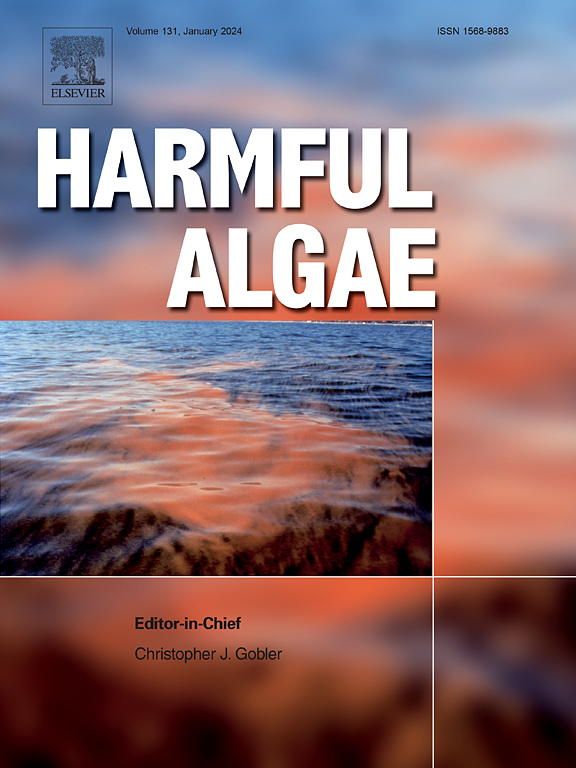有毒硅藻拟多纹藻基因组时空多样性研究
IF 5.5
1区 生物学
Q1 MARINE & FRESHWATER BIOLOGY
引用次数: 0
摘要
了解遗传多样性的起源和维持对阐明单细胞微藻种群动态、微进化历史和适应能力具有重要意义。浮游、产软骨藻酸的硅藻伪多纹硅藻在世界海洋中普遍分布,过去基于少数基因组位点的种群遗传学研究已经在那不勒斯湾(意大利)显示出不同年份的明确时间结构。尽管这种生物具有重要的生态和毒理学意义,但关于其在整个基因组和种群水平上的多样性的详细信息仍然缺乏。我们在那不勒斯湾收集了5个不同年份的多纹线虫菌株,在亚得里亚海、墨西哥湾和新西兰海岸获得了菌株,并在高覆盖率下对28个菌株进行了全基因组重测序。虽然来自前三个地理区域的菌株能够产生软骨藻酸毒素,但据报道,新西兰菌株是无毒的。结果表明,毒性菌株与无毒菌株间软骨藻酸生物合成(dab)基因序列差异很小,无毒菌株的dab基因未发现破坏性突变。另一方面,dab基因在有毒菌株中的表达水平高于无毒菌株,这表明在该物种中,没有毒性是由基因调控而不是dab序列差异解释的。变异分析表明,新西兰菌株的空间遗传结构强于时间遗传结构,新西兰菌株与其他菌株有明显的分离,新西兰菌株具有更多的选择基因。总的来说,不同群体的基因组,包括来自无性繁殖的菌株,似乎没有包含重大的重排。我们的发现有助于扩大我们对硅藻多样性的理解,硅藻多样性是硅藻成功的关键因素,并为长期存在的伪尼茨氏菌毒性问题提供了新的数据。本文章由计算机程序翻译,如有差异,请以英文原文为准。
Genomic diversity in time and space in the toxic diatom Pseudo-nitzschia multistriata
Understanding the origin and maintenance of genetic diversity is crucial to elucidate population dynamics of unicellular microalgae, their microevolutionary history and their adaptive ability. The planktonic, domoic acid-producing diatom Pseudo-nitzschia multistriata has a ubiquitous distribution in the world oceans and past population genetics studies, based on few genomic loci, have shown a clear temporal structure over different years in the Gulf of Naples (Italy). Despite the ecological and toxicological importance of this organism, detailed information on its diversity across the whole genome and at the population level is still lacking. We collected P. multistriata strains in the Gulf of Naples in five different years, obtained strains from the Adriatic Sea, the Gulf of Mexico and New Zealand coasts, and resequenced the whole genomes of a total of 28 strains at high coverage. While strains from the first three geographical areas were capable of producing the toxin domoic acid, the New Zealand strains had been reported to be non-toxic. A comparison of the domoic acid biosynthetic (dab) genes sequences between toxic and non-toxic strains showed very little variation among the strains, and no disrupting mutation was found in the dab genes in the non-toxic strains. On the other hand, the dab genes showed higher levels of expression in toxic strains than in non-toxic strains, suggesting that, in this species, absence of toxicity is explained by gene regulation rather than dab sequence divergence. Variant analysis showed stronger spatial than temporal genetic structuring and a clear separation was observed between the New Zealand strains and the others, the former having a greater content of genes under selection. Overall, the genomes of the different groups, including strains from a clonal bloom, did not appear to contain major rearrangements. Our findings contribute to enlarging our understanding of diatom diversity, a key factor underlying diatom success, and provide novel data on the longstanding problem of Pseudo-nitzschia toxicity.
求助全文
通过发布文献求助,成功后即可免费获取论文全文。
去求助
来源期刊

Harmful Algae
生物-海洋与淡水生物学
CiteScore
12.50
自引率
15.20%
发文量
122
审稿时长
7.5 months
期刊介绍:
This journal provides a forum to promote knowledge of harmful microalgae and macroalgae, including cyanobacteria, as well as monitoring, management and control of these organisms.
 求助内容:
求助内容: 应助结果提醒方式:
应助结果提醒方式:


